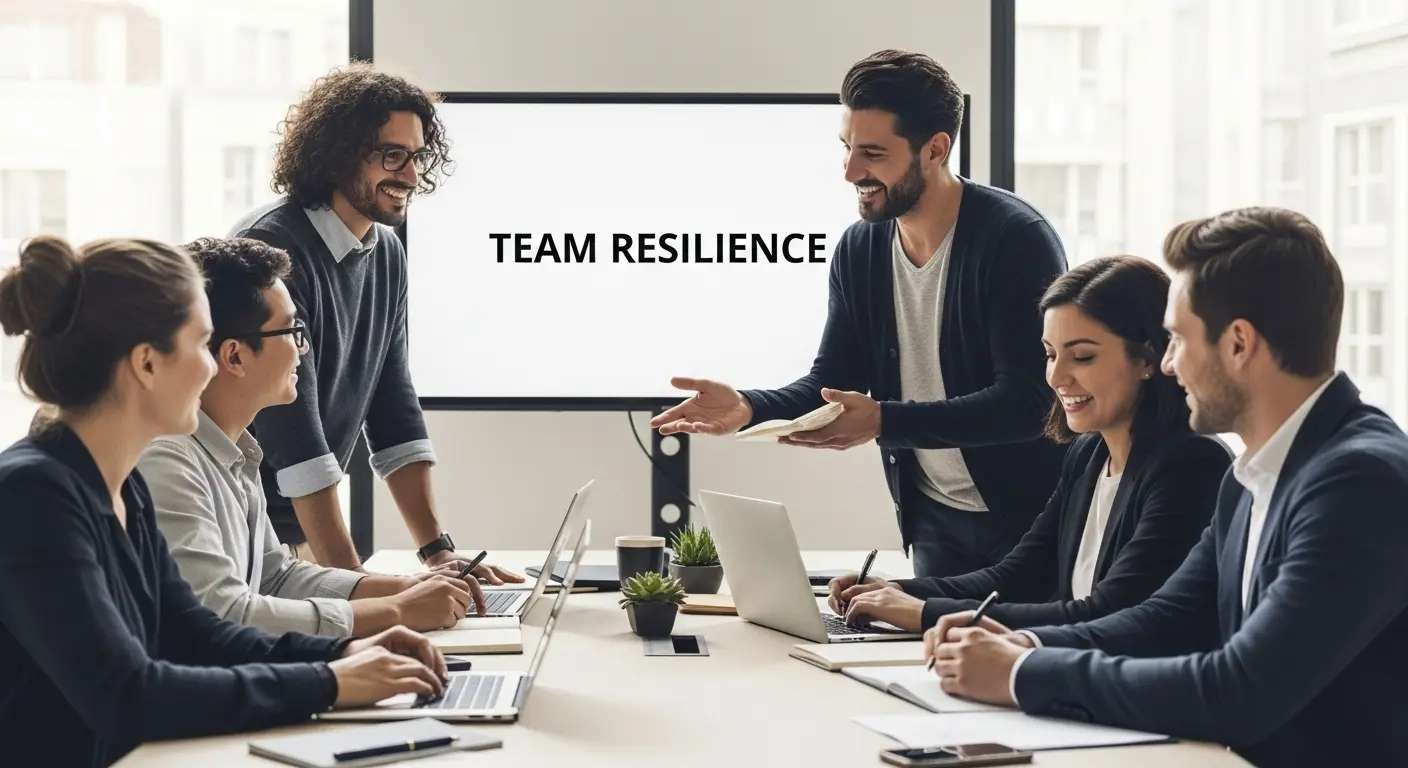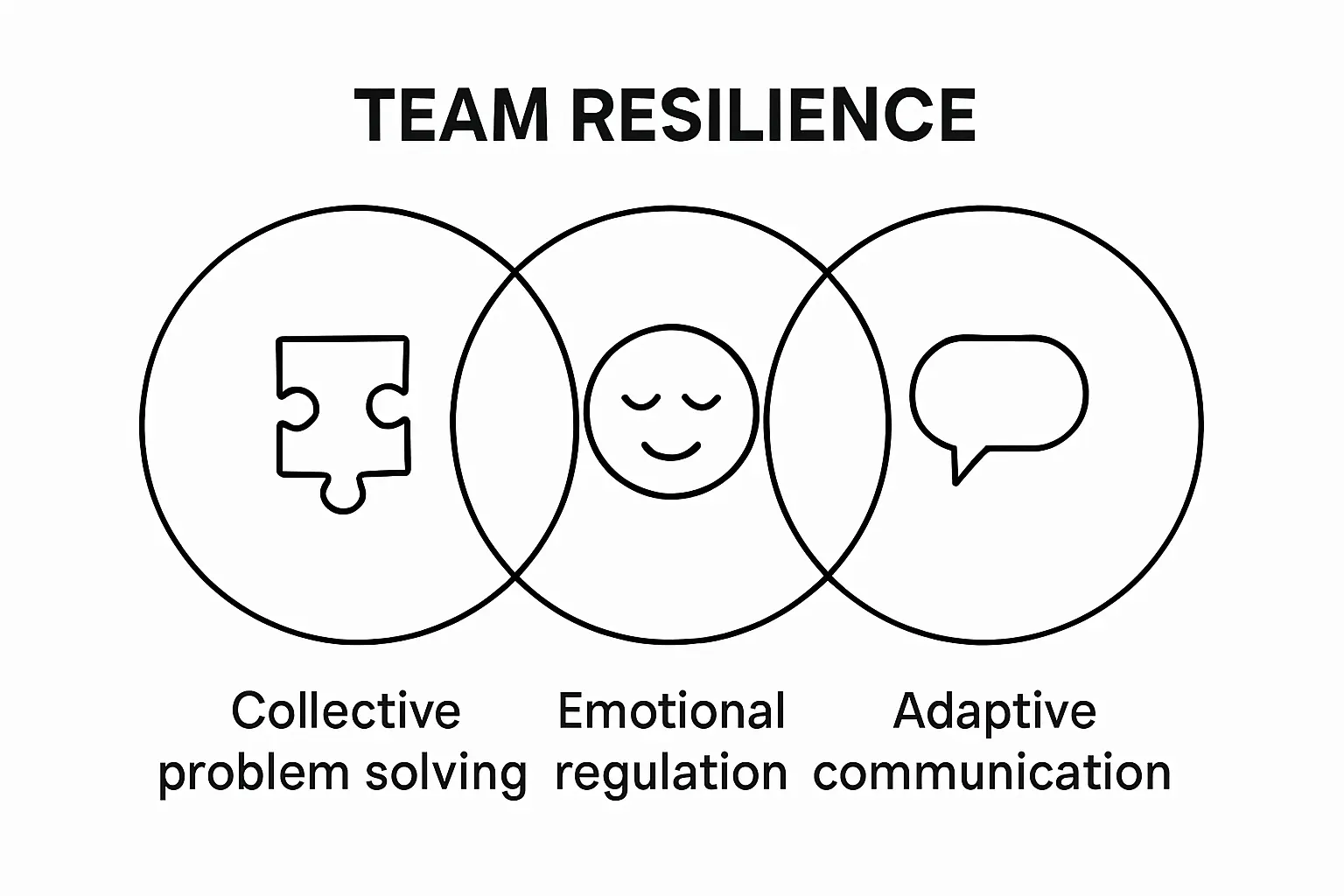Understanding Building Resilience in Teams for Success

Resilience is often seen as a personal strength but within teams it becomes a powerful force that can transform the toughest workplace setbacks into platforms for progress. Some teams not only survive stress but actually improve their performance under it. In fact, studies show resilient teams are far more likely to turn challenges into opportunities for growth and innovation. The secret is not just endurance. It is a mix of emotional intelligence, shared trust, and quick-thinking collaboration that rewrites the rules for how success happens in demanding environments.
Table of Contents
- Defining Resilience In Teams: What It Means
- The Importance Of Resilience In Team Dynamics
- Key Components Of Team Resilience: Exploring Core Factors
- How Resilience Enhances Performance And Innovation In Teams
- Practical Applications Of Resilience: Real-World Examples
Quick Summary
| Takeaway | Explanation |
|---|---|
| Foster Collective Problem Solving | Encourage teams to collaboratively tackle challenges, leveraging diverse perspectives for effective solutions. |
| Emphasise Emotional Regulation | Promote the management of group emotions to maintain productivity during stressful times. |
| Cultivate Psychological Safety | Create an environment where members feel secure sharing ideas and vulnerabilities without fear of judgement. |
| Implement Adaptive Communication | Maintain open dialogues, particularly in high-pressure situations, to ensure clarity and responsiveness. |
| Encourage Continuous Learning | Foster a culture of learning from experiences and mistakes to drive innovation and improvement in strategies. |
Defining Resilience in Teams: What It Means
Resilience in teams represents a collective psychological capacity that enables groups to effectively navigate, adapt, and recover from challenging workplace situations. Unlike individual resilience, team resilience involves complex interpersonal dynamics, shared cognitive processes, and mutual support mechanisms that transform potential setbacks into opportunities for growth and learning.
The Core Components of Team Resilience
Building resilience in teams is not about avoiding difficulties but developing robust strategies to manage and overcome them. According to research from the National Center for Biotechnology Information, team resilience comprises several critical elements:

- Collective Problem Solving: The ability of team members to collaboratively address challenges
- Emotional Regulation: Managing group emotional responses during high-stress situations
- Adaptive Communication: Maintaining open, transparent dialogue even under pressure
Psychological Mechanisms Behind Team Resilience
Team resilience functions through intricate psychological processes where group members collectively draw on shared cognitive resources. This involves creating a supportive environment where individual strengths complement potential weaknesses. Each team member contributes unique perspectives and capabilities, forming a comprehensive adaptive system that can respond dynamically to unexpected challenges.
Interesting insights suggest that resilient teams do not merely survive difficult circumstances but actively use them as catalysts for innovation and improvement. They view challenges as opportunities to refine strategies, strengthen interpersonal connections, and develop more sophisticated problem solving approaches.
Read more about effective stress management strategies for leaders to understand how leadership plays a crucial role in cultivating team resilience. The process requires deliberate cultivation of trust, mutual respect, and a shared commitment to collective growth and performance.
The Importance of Resilience in Team Dynamics
Team dynamics represent the intricate web of interactions, relationships, and psychological processes that determine a group’s overall performance and effectiveness. Resilience emerges as a critical factor in transforming these dynamics from potential vulnerability to sustainable strength, enabling teams to navigate complex workplace challenges with remarkable adaptability and collective intelligence.
Psychological Impact on Collaborative Performance
Resilience fundamentally reshapes how teams perceive and respond to challenges. According to research from the American Psychological Association, resilient teams demonstrate superior capacities for managing interpersonal conflicts, maintaining positive morale, and sustaining productivity under pressure. The psychological mechanisms underlying team resilience include:
- Emotional Intelligence: Understanding and managing collective emotional responses
- Shared Mental Models: Developing unified understanding of team objectives and strategies
- Mutual Trust: Creating supportive environments where vulnerability is accepted
Strategic Benefits of Team Resilience
Beyond psychological well-being, team resilience delivers tangible strategic advantages for organizations. Resilient teams can rapidly recalibrate their approaches, absorb unexpected disruptions, and transform potential setbacks into opportunities for innovation and growth. This adaptive capacity becomes particularly crucial in rapidly changing professional environments where flexibility determines competitive advantage.
Leadership plays a pivotal role in cultivating these dynamics. By establishing transparent communication channels, encouraging collaborative problem solving, and modeling constructive response to challenges, leaders can systematically build team resilience. Learn more about essential leadership skills for developing team resilience to understand how strategic interventions can transform team performance.
Ultimately, team resilience is not about eliminating challenges but developing the collective capacity to navigate them effectively, turning potential obstacles into pathways for continuous improvement and organizational success.
Key Components of Team Resilience: Exploring Core Factors
Team resilience is not a singular trait but a complex interplay of multiple interconnected psychological and organizational factors. Understanding these core components provides insights into how teams can develop robust mechanisms for navigating challenging workplace environments and maintaining peak performance under pressure.
Foundational Psychological Elements
Research from the National Center for Biotechnology Information highlights several critical psychological components that underpin team resilience. These foundational elements create a comprehensive framework for understanding collective adaptive capacity:
- Psychological Safety: Creating an environment where team members feel secure expressing vulnerabilities
- Shared Cognitive Understanding: Developing unified mental models about team objectives
- Emotional Regulation: Managing group emotional responses during high stress situations
Structural Dynamics of Resilient Teams
Resilient teams possess specific structural characteristics that distinguish them from less adaptable groups. These characteristics include clear communication protocols, flexible role definitions, and mechanisms for continuous learning and adaptation. The ability to redistribute cognitive and emotional resources during challenging situations becomes a key differentiator.
Team members in resilient environments demonstrate an extraordinary capacity to anticipate potential challenges, proactively develop contingency strategies, and maintain constructive perspectives even when confronting significant obstacles. This requires a sophisticated blend of individual capabilities and collective coordination.
To clarify and summarise the essential elements that make up team resilience, the table below outlines the core psychological and structural components discussed in the article.
| Component | Description |
|---|---|
| Psychological Safety | A safe environment for team members to express ideas, questions, and vulnerabilities without fear. |
| Collective Problem Solving | The ability for team members to collaborate and address challenges together. |
| Emotional Regulation | Managing and guiding emotional responses within the group during stress or crisis. |
| Adaptive Communication | Open and transparent dialogue maintained even under pressure. |
| Shared Cognitive Understanding | Developing unified team mental models regarding objectives and strategies. |
| Flexibility of Roles | Willingness to adapt and redistribute roles and responsibilities as needs arise. |
| Continuous Learning | Emphasis on learning from experiences and mistakes to promote team growth and innovation. |
Explore strategies for managing remote team dynamics to understand how these resilience principles apply across different workplace configurations. The principles remain consistent whether teams are co-located or distributed across multiple geographical locations.
Ultimately, building team resilience is an ongoing process of intentional cultivation, requiring consistent investment in interpersonal skills, shared understanding, and adaptive organizational practices.
How Resilience Enhances Performance and Innovation in Teams
Team resilience transcends traditional performance metrics, representing a sophisticated approach to organizational adaptability that directly influences productivity, creativity, and strategic responsiveness. By transforming challenges into opportunities for growth, resilient teams create a dynamic environment where innovation emerges naturally from collective problem solving and shared commitment.
Performance Optimization Mechanisms
According to research published in organizational psychology journals, resilient teams demonstrate remarkable capabilities in converting potential setbacks into strategic advantages. These performance optimization mechanisms include:
- Rapid Problem Recalibration: Quickly adjusting strategies in response to unexpected challenges
- Cognitive Flexibility: Maintaining creative thinking under high stress conditions
- Collective Learning: Transforming individual experiences into team wide knowledge
Innovation Through Adaptive Thinking
Resilient teams cultivate an innovative mindset by viewing challenges as opportunities for creative exploration. This approach requires a fundamental shift from reactive problem management to proactive opportunity identification. Team members develop a shared understanding that complexity is not a barrier but a catalyst for breakthrough thinking.
The psychological safety inherent in resilient teams allows members to experiment, propose unconventional solutions, and challenge existing paradigms without fear of negative repercussions. This environment becomes a breeding ground for transformative ideas that can fundamentally reshape organizational approaches.
Discover creative strategies for remote team building to understand how innovative team dynamics can be cultivated across different workplace configurations. These approaches demonstrate that resilience is not confined by physical boundaries but is a mindset of collective adaptability and continuous improvement.
Ultimately, team resilience represents a strategic capability that enables organizations to navigate complex environments with agility, turning potential disruptions into opportunities for sustained growth and competitive advantage.
Practical Applications of Resilience: Real-World Examples
Resilience is not an abstract theoretical concept but a practical skill set that can be observed and implemented across diverse professional environments. Real-world applications demonstrate how teams transform challenges into opportunities through strategic psychological and organizational approaches.
Healthcare Team Resilience During Crisis
Research from the American Psychological Association highlights extraordinary examples of team resilience in high-pressure environments. Healthcare professionals during the COVID-19 pandemic exemplified remarkable adaptive capabilities by:
- Rapid Protocol Adaptation: Quickly modifying treatment approaches in response to emerging viral understanding
- Cross-Functional Collaboration: Implementing seamless communication across specialized medical teams
- Emotional Support Mechanisms: Creating robust psychological support systems for frontline workers
Technology and Innovation Sector Resilience
Technology organizations frequently encounter unpredictable market shifts and technological disruptions. Resilient teams in this sector distinguish themselves by maintaining innovation momentum despite external uncertainties. They accomplish this through continuous learning, flexible work structures, and a proactive approach to potential challenges.
Successful technology teams develop comprehensive strategies that include scenario planning, continuous skill development, and creating redundant knowledge systems. This approach ensures that individual team member transitions or unexpected market changes do not compromise overall team performance.
The following table compares the practical applications of resilience in healthcare and technology sector teams, as described in the article.
| Sector | Key Resilience Strategies | Outcomes |
|---|---|---|
| Healthcare | Rapid protocol adaptation, cross-functional collaboration, emotional support | Maintained care quality, protected staff wellbeing, adapted swiftly |
| Technology/Innovation | Scenario planning, flexible structures, continuous learning, knowledge redundancy | Sustained innovation, coped with market shifts, ensured performance |
Explore innovative remote team building strategies to understand how organizations can cultivate resilience across distributed work environments. These approaches demonstrate that resilient teams can maintain high performance regardless of physical location or immediate contextual challenges.
Ultimately, practical resilience emerges from intentional cultivation of adaptive mindsets, robust communication protocols, and a collective commitment to transforming challenges into opportunities for growth and innovation.

Turn Team Resilience Into Lasting Organisational Success
Is your team struggling to remain adaptable and united during challenging times? As explored above, collective resilience is more than just weathering problems. It relies on robust communication, psychological safety, and continuous innovation to transform obstacles into growth opportunities. Yet many membership-based organisations find it difficult to create this kind of environment consistently, especially when juggling multiple events, communications and member needs.

Colossus Systems empowers your teams to build resilience from the ground up. Our unified SaaS platform effortlessly streamlines member management, fosters seamless collaboration and supports dynamic event planning. With our solutions, you can develop adaptive strategies, centralise communication, and nurture a culture of trust that elevates both performance and engagement. Discover how you can cultivate resilient teams and drive real change. Take the first step towards strengthening your organisation today by reaching out to our team.
Frequently Asked Questions
What does it mean to build resilience in teams?
Building resilience in teams refers to the collective psychological capacity that allows a group to navigate, adapt, and recover from challenging situations effectively, transforming setbacks into opportunities for growth.
What are the core components of team resilience?
Key components of team resilience include collective problem solving, emotional regulation, and adaptive communication. These elements help teams better manage challenges and maintain positive dynamics.
How does resilience impact team performance and innovation?
Resilience enhances team performance by allowing members to quickly recalibrate strategies in response to challenges, maintain cognitive flexibility, and create a culture of collective learning, which fosters innovation.
What practical strategies can teams implement to build resilience?
Teams can build resilience by establishing psychological safety, encouraging clear communication, promoting cross-functional collaboration, and facilitating continuous skill development, which all contribute to a supportive and adaptable team environment.
Recommended
- Effective Stress Management for Leaders: Master Your Resilience|CS
- 7 Essential Leadership Skills for Students to Develop|CS
- 8 Creative Remote Team Building Ideas for Your Organisation|CS
- Understanding Managing Remote Teams: Key Concepts Explained|CS
- Understanding Team Building Tips 2025 for Effective Teams - Blog
- Building Resilience: Quotes to Keep You Moving Forward